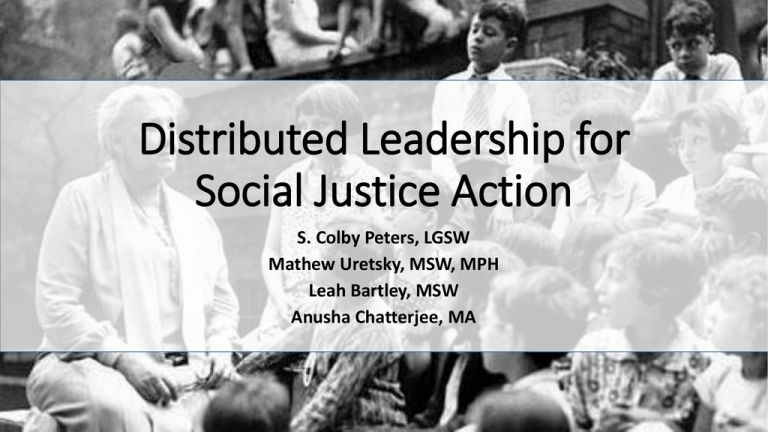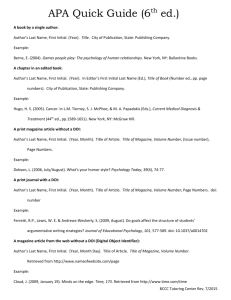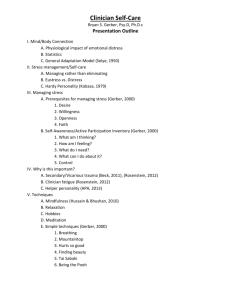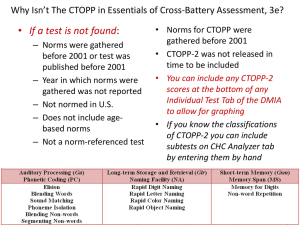Distributed Leadership for Social Justice Action
advertisement

Distributed Leadership for Social Justice Action S. Colby Peters, LGSW Mathew Uretsky, MSW, MPH Leah Bartley, MSW Anusha Chatterjee, MA Background Where is the social justice in social work? • Advocacy ranked low on social workers’ list of priorities • Lack of participation in public policy formation • Engagement in social justice at individual level, but not organizational or societal level Why aren’t social workers engaging in social justice actions? • • • • Psychological and individual approach to social work Managerialism and professionalism Organizational culture Social work education does not translate the pursuit of social justice into specific advocacy techniques The qualities and skills needed to promote social justice are encompassed in social work leadership Client Outcomes Distributed Leadership Social Work Leadership Behaviors Advocates for clients and organization Thinks critically • Increased opportunities to Client Outcomes engage in organizational activities that directly affect Social Worker Outcomes him orSocial her toWorker • Committed organization and social justice Outcomes • Politically savvy Organizational Outcomes • Visionary Culture ofdiversity leadership, not •• Manages Organizational managerialism Outcomes • Adherence to mission and vision Social Work Profession Outcomes Professional • Increased promotion of Outcomes social work values Global Outcomes Global Outcomes • Social justice A Theory of Social Justice Promotion Increases in distributive leadership in the workplace predict increases in subjective norms associated with the promotion of social justice. Attitude Distributed Leadership Subjective Norms Intention Perceived Behavioral Control Ajzen’s Theory of Planned Behavior (1991) Behavior Distributed leadership may contribute to an increase in advocacy for social justice • Distributed leadership: Emergent leadership based on knowledge, time, and context, consisting of a concerted action by a group of individuals for the purpose of achieving a common goal. Research Question Do increased levels of distributed leadership in the workplace predict increases in social justice actions? Method and Results Organizational Inputs and Social Workers’ Management of Secondary Trauma in the Workplace May – August 2013 Sampling Frame • 483 licensed social workers in PA and MD from state licensure lists Response • 174 surveys returned • 166 valid surveys • 34.3% response rate Exclusions • Missing data on SJS and DL scales • Not currently working as social workers n % Female 127 91% Partnered/Married 96 69% White/Non-Hispanic 118 84% Sample Size • 130 final sample size Scales • Subjective Norms Subscale, Social Justice Scale (Torres-Harding, Siers, & Olson, 2012) • 4 items • Alpha = .88 • Sample question: On a scale of 1 to 7, please indicate to what extent people around you are engaged in activities that address social injustices in your workplace. • Distributed Leadership Subscale, Leadership Scale, Comprehensive Organizational Health Assessment (Fritzler & Leake, 2012) • 3 items • Alpha = .97 • Sample question: On a scale of 1 to 6, the leadership of our organization views leadership as shared by staff and administrators. Hierarchical Regression Analysis* Independent Variables Step 1 - Demographics • Ethnicity: Caucasian non-Hispanic, Other • Gender: Male, Female • Marital Status: Partnered/Married, Other Step 2 – Distributed Leadership • Distributed leadership subscale *All assumptions for OLS regression were met. Dependent Variable Subjective norms related to social justice promotion • Subjective norms subscale Results Increases in distributive leadership in the workplace predict increases in subjective norms associated with the promotion of social justice. Subjective Norms Distributed Leadership + 1 point R2 = .123 Colleagues display positive attitude toward social justice and engage in social justice actions + 1.4 points Implications, Limitations, and Future Research Implications • Distributed leadership social worker leadership behaviors leadership culture social justice promotion • Distributed leadership may counterbalance managerialism • Basing organizational structure and function on principles of social justice may enable social workers to engage in more advocacy • Social workers who feel comfortable addressing structural and functional issues in their organization may translate into addressing structural inequalities in societal institutions Limitations • Subscales have not been used alone in previous studies • Sample not diverse • Potential private practice respondents • Didn’t define “social justice” Future Research • More extensive assessment of distributed leadership practices over time and across organizations • More detailed assessment of social justice promotion in an organization • Specific actions taken by social workers in the promotion of social justice inside and outside of the organization How do we promote social justice? Social workers must: • Apply principles of social justice to their organizations • Retain a critical stance to existing organizational and societal structures that promote inequality • Advocate for change on multiple levels References • Austin, M. J., Regan, K., Samples, M. W., Schwartz, S. L., & Carnochan, S. (2011). Building managerial and organizational capacity in nonprofit human service organizations through a leadership development program. Administration in Social Work, 35, 258-281. • Bennett, N., Wise, C., Woods, P. A., & Harvey, J. A. (2003). Distributed leadership: A review of literature. • Breton. (2012). Small steps toward social justice. Social Work with Groups, 35(3), 205-217. doi:10.1080/01609513.2011.624369 • Collinson, D. (2014). Dichotomies, dialectics and dilemmas: New directions for critical leadership studies? Leadership, 10, 36-55. • Coloma, J., Gibson, C., & Packard, T. (2012). Participant outcomes of a leadership development initiative in eight human service organizations. Administration in Social Work, 36, 4-22. • Craig, G. (2002). Poverty, social work and social justice. British Journal of Social Work, 32(6), 669682. • Dinh, J. E., Lord, R. G., Gardner, W. L., Meuser, J. D., Liden, R. C., & Hu, J. (2013). Leadership theory and research in the new millennium: Current theoretical trends and changing perspectives. The Leadership Quarterly, 25, 36-62. • Dodd. (2004). Expanding the boundaries of ethics education: Preparing social workers for ethical advocacy in an organizational setting. Journal of Social Work Education, 40(3), 455-465. • Dudziak, S., & Profitt, N. J. (2012). Group work and social justice: Designing pedagogy for social change. Social Work with Groups, 35, 235-252. doi:10.1080/01609513.2011.624370 References (cont’d) • Fritzler, P., & Leake, R. (2012). Comprehensive organizational health assessment. Unpublished manuscript. • Hannah, S. T., Sumanth, J. J., Lester, P., & Cavarretta, F. (2014). Debunking the false dichotomy of leadership idealism and pragmatism: Critical evaluation and support of newer genre leadership theories. Journal of Organizational Behavior, • Healy, K. (2005). Dominant discourses in health and welfare: Biomedicine, economics and law. service discourses: ‘Psy’ and sociological ideas in social work. . Social work theories in context: Creating frameworks for practice. (pp. 17-67). New York, NY: Palgrave MacMillan. • Holosko, M. J. (2009). Social work leadership: Identifying core attributes. Journal of Human Behavior in the Social Environment, 19, 448-459. • Jabour. (2012). Relationship and leadership: Sophonisba breckinridge and women in social work. Affilia, 27, 22-37. doi:10.1177/0886109912437496 • Knee, R. T., & Folsom, J. (2012). Bridging the crevasse between direct practice social work and management by increasing the transferability of core skills. Administration in Social Work, 36, 390-408. doi:10.1080/03643107.2011.604402 • Lawler, J. (2007). Leadership in social work: A case of caveat emptor? British Journal of Social Work, 37(1), 123-141. • McLaughlin, A. M. (2009). Clinical social workers: Advocates for social justice. Advances in Social Work, 10(1), 51-68. • Mizrahi, T., & Berger, C. S. (2005). A longitudinal look at social work leadership in hospitals: The impact of a changing health care system. Health & Social Work, 30, 155-165. References (cont’d) • O'Brien, M. (2011). Equality and fairness: Linking social justice and social work practice. Journal of Social Work, 11(2), 143158. • O'Brien, M. (2011). Social justice: Alive and well (partly) in social work practice? International Social Work, 54(2), 174-190. • Olson. (2013). Voices from the field: Social workers define and apply social justice. Journal of Progressive Human Services, 24(1), 23-42. doi:10.1080/10428232.2013.740407 • Rank, M. G., & Hutchison, W. S. (2000). An analysis of leadership within the social work profession. Journal of Social Work Education, 36, 487-502. . • Thorpe, R., Gold, J., & Lawler, J. (2011). Locating distributed leadership. International Journal of Management Reviews, 13, 239-250. • Torres-Harding, S. R., Siers, B., & Olson, B. D. (2012). Development and psychometric evaluation of the social justice scale (SJS). American Journal of Community Psychology, 50, 77-88. • Webster. (2010). Complexity approach to frontline social work management: Constructing an emergent team leadership design for a managerialist world. Social Work & Social Sciences Review, 14(1), 27-46. doi:10.1921/095352210X518162 • Webster, M. (2013). A vision for social work leadership: Critical conceptual elements. Social Workers Registration Board: Protecting the Public, Enhancing the Profession, • Yliruka. (2013). How can we enhance productivity in social work? dynamically reflective structures, dialogic leadership and the development of transformative expertise. Journal of Social Work Practice, 27, 191-206. doi:10.1080/02650533.2013.798157 Images Slide 1 – Jane Addams with immigrant children, retrieved 6.2.2014 from http://www.dailykos.com/story/2012/01/24/1057949/-The-Second-Deathof-Jane-Addams# Slide 3 – Whitney M. Young, Jr., retrieved on 6.2.2014 from http://mije.org/richardprince/telenovelas-trump-state-union Slide 4 – Harry Hopkins, WPA Administrator, visits Arkansas families displaced by flooding, retrieved on 6.2.2014 from http://www.cssny.org/index.php/preview/news/harry-hopkins-from-css-tofdrs-new-deal Slide 6 – Jeannette Rankin, retrieved on 6.2.2014 from http://www.politico.com/news/stories/0409/20776.html Slide 17 – Dorothy Height, members of Sigma Theta Delta sorority, and Mamie Eisenhower, retrieved on 6.2.2014 from http://www.npr.org/templates/story/story.php?storyId=126136771 S. Colby Peters, LGSW speters@ssw.umaryland.edu











